I first saw Dean Stockwell’s performance of “In Dreams” in Blue Velvet, when I was 14 years old. I watched the film in my basement late one summer night with my friend Laura, an avid film buff. Laura introduced me to David Lynch by first showing me Blue Velvet, followed by Eraserhead (after I watched Eraserhead I couldn’t eat anything; I knew I would vomit if I tried). These films, and many others Laura showed me, definitely changed my life. I lived in a sprawling suburb in the middle of nowhere in Indiana, so the rapid and frequent exposure to arthouse, cult, and world cinema was like receiving an intensive cultural and artistic education, for which I will always be grateful.
As I watched the opening scenes of Blue Velvet, I knew I was seeing a very different kind of film. But it spoke my language. The smiling, waving firemen, the white picket fences, and the rose bushes made me laugh. I already knew that these elements masked the brutal realities of addiction, domestic violence, abuse, and neglect hidden within many suburban homes. And when I saw the monstrous pile of black beetles tearing each other apart beneath the healthy green lawn, something in me seemed to nod in recognition; I knew what I was seeing was true.

Blue Velvet scared and enchanted me, and although there are several memorable moments in this film, the scene that always stuck with me was Dean Stockwell’s silent performance the Roy Orbison song, “In Dreams.” Anytime I watch Blue Velvet, I look forward to this scene, and when I learned that Stockwell passed away, I felt compelled to write about it, in part to discover what I really thought about it, but also to highlight and honor Stockwell’s captivating performance.
If you haven’t seen Blue Velvet in a while, Stockwell’s scene occurs after Frank Booth (Dennis Hopper) catches Jeffrey Beaumont (Kyle MacLachlin) leaving Dorothy Vallen’s (Isabella Rossellini) apartment. Frank and his men accost Jeffrey and Dorothy, take them hostage, and drive them to Ben’s house. As they approach Ben’s house, Frank says, “This is it!” There is a red neon sign in the front window of Ben’s house bearing the same phrase: “THIS IS IT.” The entrance to Ben’s house looks more like an office building or a funeral home than a private residence, but like so many things in the strange town of Lumberton, somehow it makes sense.
A Staged Scene
Many people use the word “Lynchian” to describe Lynch’s style, but to me, the term is meaningless. I consider Lynch, above all else, to be an intentional filmmaker. It’s not that every lamp or background painting is laden with symbolic meaning; rather, I feel that Lynch follows his intuition in order to stay true to the original idea, and in doing so, he intentionally uses specific objects, colors, and people to create the world he is trying to capture on film. Therefore, I want to begin by examining the concrete elements of this scene, which takes place inside Ben’s house.
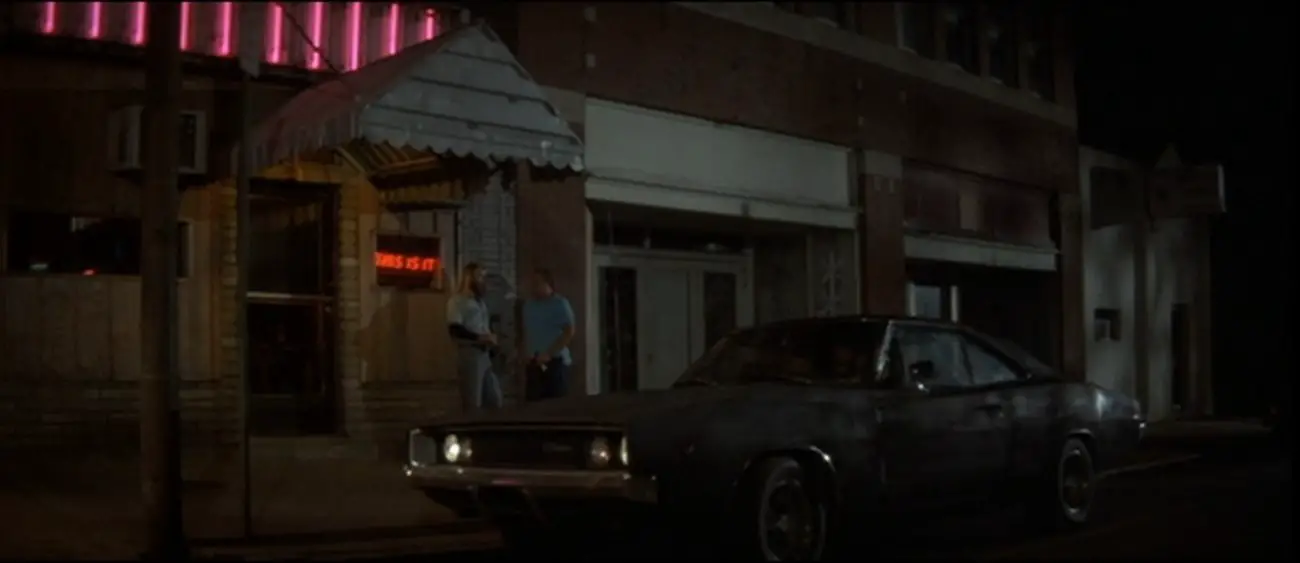
As I said, the entrance to Ben’s house looks nothing like a home, and the interior is even more bizarre. Near the front door, a painting of a reclined nude woman hangs above a small couch. A set of faded mint curtains frames both sides of the entryway, which makes this area resemble a stage. The other side of the room consists of a larger seating area and a wooden door leading to the room where Dorothy’s son is held hostage. But we never see inside of this room; it remains out of view, like a backstage area viewed from the seats of a theater. Without fail, this room never ceases to elicit my desire to see what and who is hidden within it.
The walls of Ben’s house are a faded pink color, and the whole house feels like someone’s memory of their great grandparents’ sitting room, something half remembered and reconstructed piece by piece in a futile attempt to recreate the past. Whatever the initial intention was, the result feels artificial. And I think this sense of artificiality makes this scene all the more surreal.

The women in Ben’s house, for the most part, are older women with large bodies: they sit silently in the background and are at the beck and call of Ben; they’re more like living statues than actors in a film. They’re props, shaped like a secretary or a typist from the 1950s. They play no clear role other than to sit, hand out glasses, and occupy space. One woman, the thinnest and perhaps the oldest, eventually leaves with the group, most notably dancing (if you can call it that) atop Frank’s car while Frank beats up Jeffrey. There is also a large man sitting at a long table who never says anything. The table is littered with cups, glass bottles, and various orange pill bottles. The people occupying this house appear as if they’ve been sedated or unconscious until Frank, his crew, Dorothy, and Jeffrey arrive. Then, they slowly wake up, but other than Ben, appear to be only marginally alive.
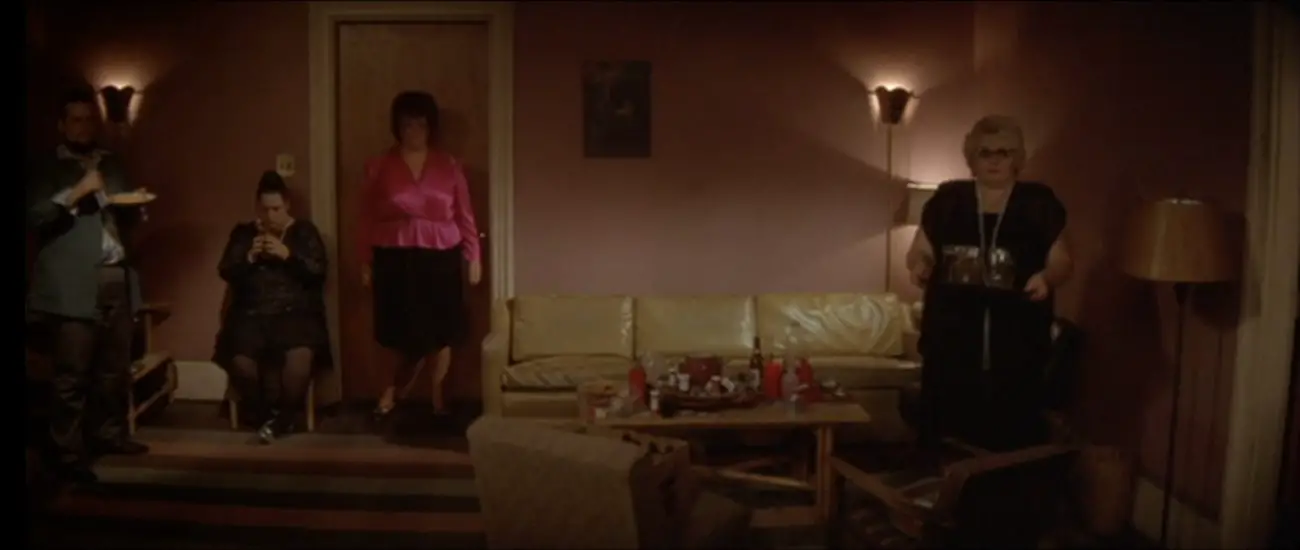
Upon entering Ben’s house, the main cast is framed by the rectangular opening and the faded mint curtains, which resembles a stage. Again, it looks constructed. As I watch, I feel I am being reminded by the filmmaker that I am a viewer. It is being indicated to me that, perhaps, this film knows it is a film; the players might be partially or fully aware that they are being watched. And yet, like “Llorando” in Mulholland Drive, Stockwell’s song seems to disrupt the continuity of the film, and the self-assuredness and perhaps even the identities of some of the characters are similarly disrupted.
“In Dreams” is a Signal
After Frank and Ben exchange pleasantries, Ben pulls Frank aside to discuss business. He hands him a small, crumpled sheet of paper, and tosses a pill in Frank’s mouth like a peanut. Frank allows Dorothy to see her child, at which point Ben begins to sing “In Dreams” by Roy Orbison. But he doesn’t actually sing, rather, he silently mouths the words; his face is painted white like a clown or a mime, and he “sings” primarily to Frank and for Frank. The single light bulb he uses as a microphone looks like something pulled from a construction site, and this prop reemphasizes that this scene is staged and consciously constructed. (Again, it reminds me of Mulholland Drive when The Magician in Club Silencio announces, “No hay banda. There is no band. It is all an illusion.”). It’s also significant that this song is performed while Dorothy is out of the room, with her son. Perhaps its purpose is, in part, to divert our attention from the seriousness of the situation.
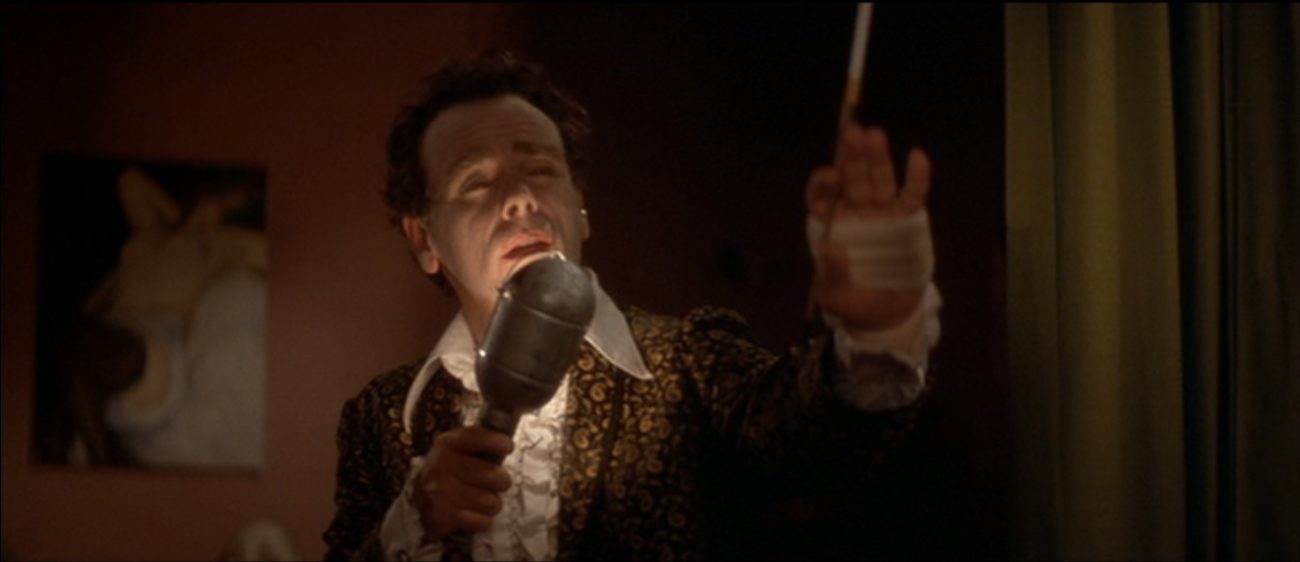
As Ben approaches the lyric, “In dreams, you’re mine, all the time,” Frank becomes deeply agitated. Ben instantly notices this; he is so attuned to Frank’s subtle and overt mood swings that he stops mouthing the words even before Frank turns the stereo off. Ultimately, “In Dreams,” is left unfinished.
Then, Frank confirms that he will see Ben on Tuesday, pauses, then utters the ominous, ambiguous reoccurring line: “Now it’s dark.” It is unclear who, if anyone, he is addressing. It is like he is commenting on something that no one else can see. Then he abruptly screams: “Let’s f*ck! I’ll f*ck anything that moves!” and bursts into maniacal laughter. When I watch this now, I feel he is doing this for us, the audience. He’s back in character after the song temporarily disrupted his sense of continuity, and he overcompensates like a comic book villain in order to recapture our attention.
Then, he (and the group) suddenly disappears, and we are left with a momentary collage: a large doll resembling a woman sits in a chair in the entryway wearing a bizarre mask which covers her head and neck; the mask looks like a melted clown face. A portrait of a naked woman hangs above her, and the yellow lines of the freeway are superimposed onto the frame. It is a strange juxtaposition of images. It feels almost as if Lynch is punctuating that this film is his unique contribution to the world of visual art; or perhaps its a kind of a commentary on visual art itself. Regardless, at this point we leave Ben’s house once and for all.
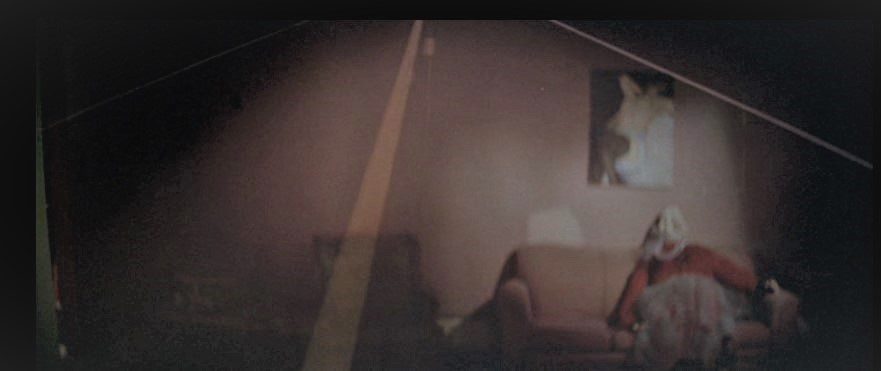
When I saw this film for the first time, I was captivated by how different Ben was than the other men in Blue Velvet. Ben is soft spoken, wears white frills, uses a long cigarette holder, and appears, in his own way, to be the most “cultured” person in Lumberton. But he also strikes Jeffrey in the stomach and works with or for Frank, so there is also a great darkness hiding behind his luminous mask. He might be the crying clown (or mime) of Lumberton, but he is also complicit in evil deeds and violence.
Stockwell’s performance is a captivating distraction from the brutality at hand, both for the characters in the room as well as the audience, and it acts as a kind of temporary sedative for Frank. For me, “In Dreams,” also signals Jeffrey’s complete descent into a nightmare, because once this song is played, they leave Ben’s house, and Jeffrey is subjected to even more of Frank’s insanity. He is threatened, beaten, and left in the mud, where he falls unconscious. The end of Ben’s song signals the end of Jeffrey being able to separate himself from the darker part of Dorothy’s world. Once he is brought to Ben’s house and hears “In Dreams,” he is thoroughly steeped in a world of darkness; he has seen and felt things that cannot be unseen or unfelt. As the sign said out front: This is it.
Whenever I watch Blue Velvet I always look forward to Stockwell’s performance. He (silently) sings with such elegance, grace, and self-assurance. For all of Frank’s raging and fear-inducing behavior, it always feels like Ben is, in some way, in control of what’s happening in the room. After all, Ben is housing the stolen child, so in a sense he is housing the unseen mystery at the heart of the story, the innocence that Jeffrey and Dorothy yearn to protect and reclaim.
“I Awake To Find You Gone”
“In Dreams” is a song of love and longing. The lyrics describe dreaming of someone you desire or love, and waking up to discover that they’re gone. But bearing in mind what I said about the staged, artificial appearance of Ben’s house, maybe the song is hinting at the loss of something else (in a sense, even Stockwell’s performance is artificial, because he doesn’t actually sing). Maybe, for Lynch, the worlds within films are the “beautiful dreams” the song refers to. Films are, by nature, ephemeral. Although we can return to the world of a film again and again, inevitably the credits roll, and we have to leave it behind. The dream always ends, and there is a sadness in letting go.
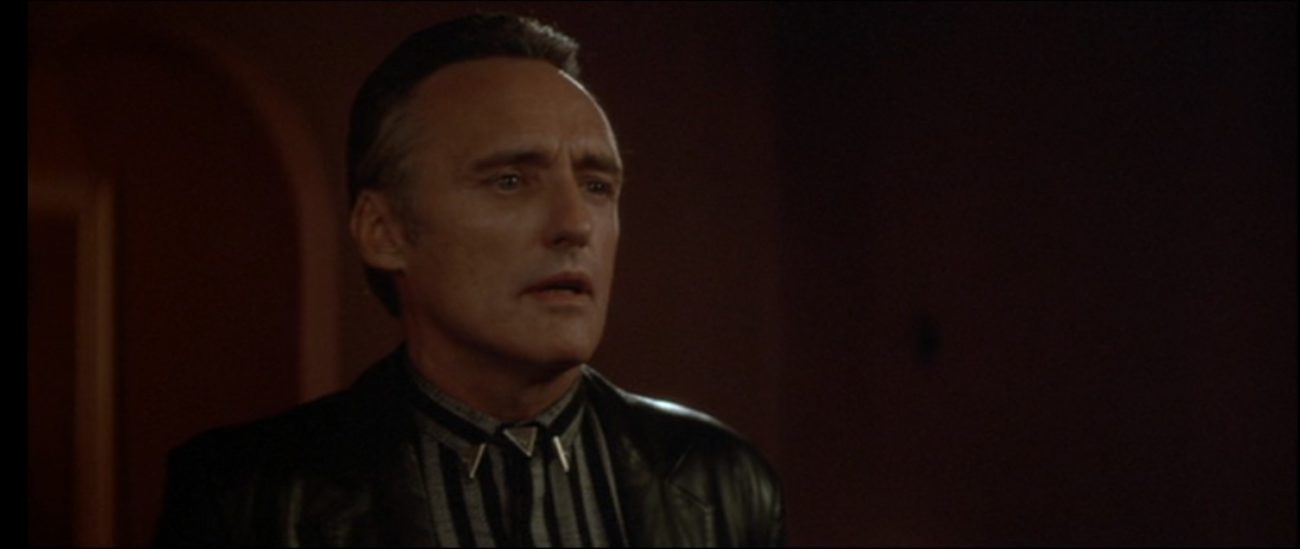
Lynch stated that “’In Dreams’ explained to me so much of what the film was all about.” [1] Perhaps the loss described in the song is inevitable process of letting go of making a film, the sadness inherent in the completion of any substantial artistic endeavor. For me, “In Dreams” tells the story of a tenuous love that culminates in a painful, inescapable loss. But whatever the meaning might be, this scene and this film have continued to captivate me for many years. I’m always intrigued by its mysteries and absurdities, and by the characters’ desires. I’m also never comfortable with many scenes, and the claustrophobic, womb-like interior of Dorothy Vallen’s apartment is a place I never want to visit. The same is true of Ben’s apartment.
These staged, constructed spaces seem to have emerged from the mind of each occupant; it’s as if their mind, their deadness, and their pain was concretized and manifested around them in physical form. And for me, observing these interiors elicits a palpable sense of discomfort. The rooms and their occupants make me curious and uncomfortable, intrigued and averse. I often find myself holding my breath, even though I know what is coming. Blue Velvet never ceases to blur my sense of myself; I become lost in the confines of a world that never existed—and yet it does, there it is on the screen, staged and constructed for my amusement.
For Dean Stockwell (1936-2021)
References
Rodley, C. Lynch on Lynch (Revised Edition), 128, Farrar, Straus, and Giroux, 2005.

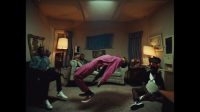

In my mind, “This is it” wasn’t a residence; it’s a brothel.
Several of your descriptions of the interior support this.
Also a couple of dudes hanging out outside, with dim pink neon above them, and a commercial setting.
That’s my take at least.